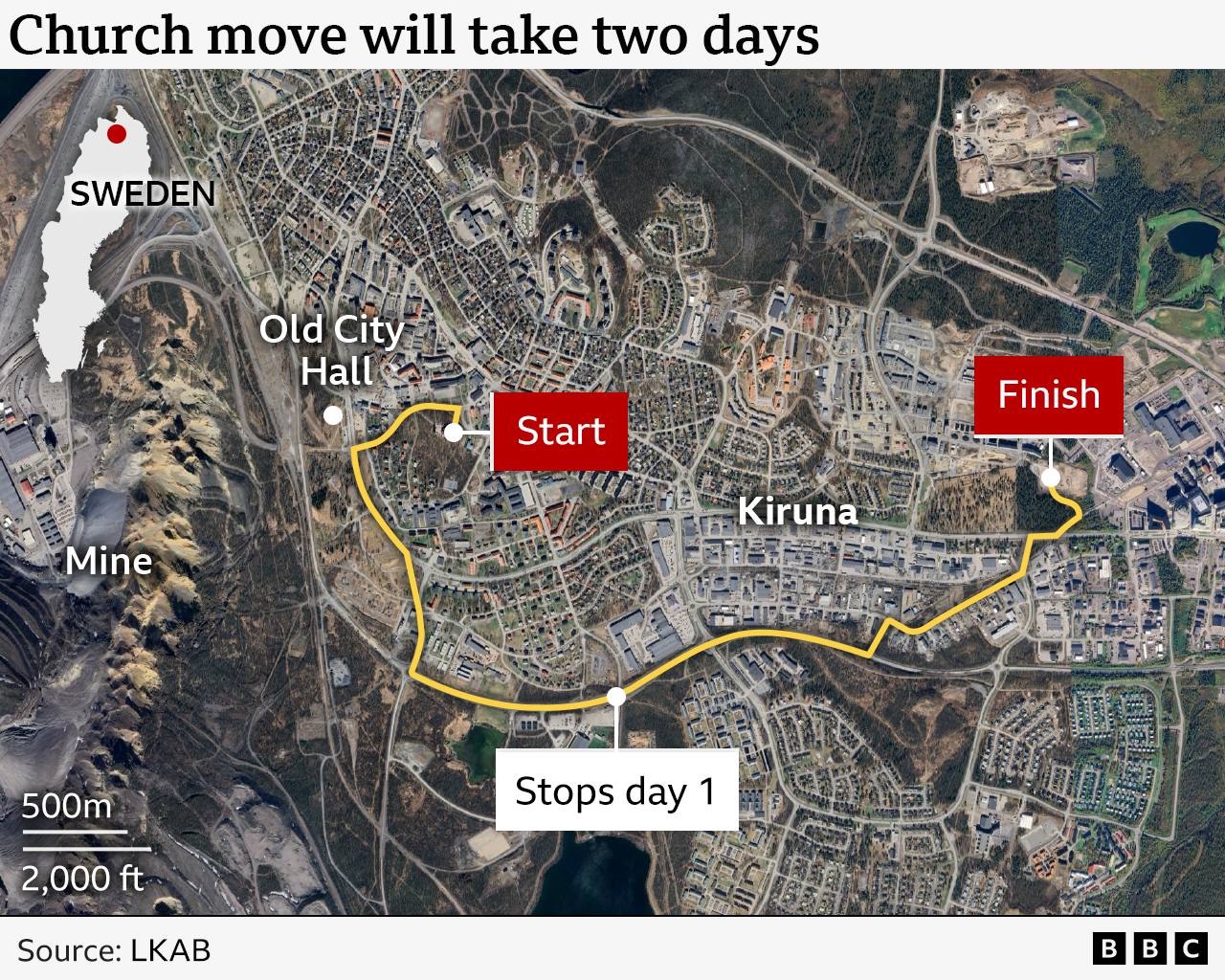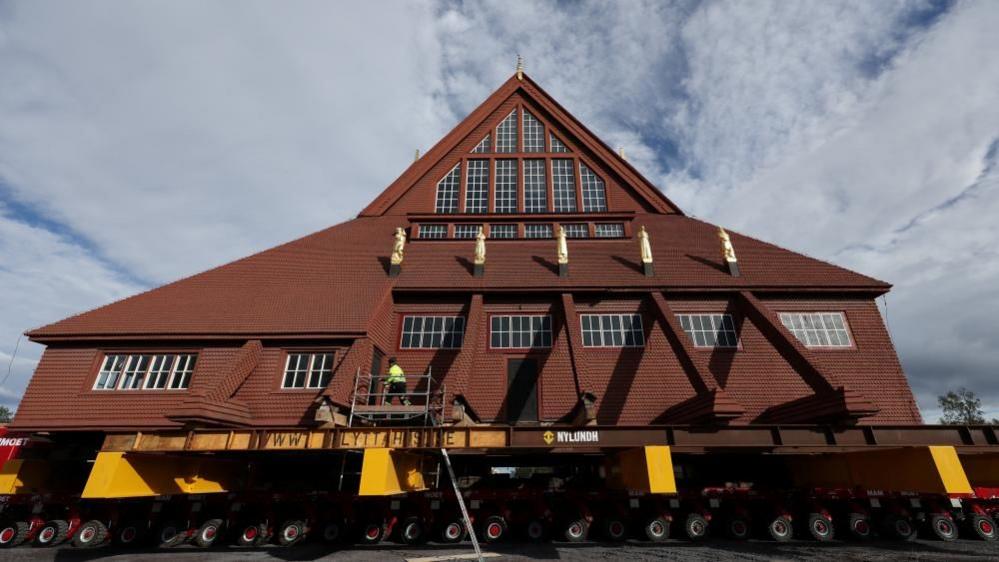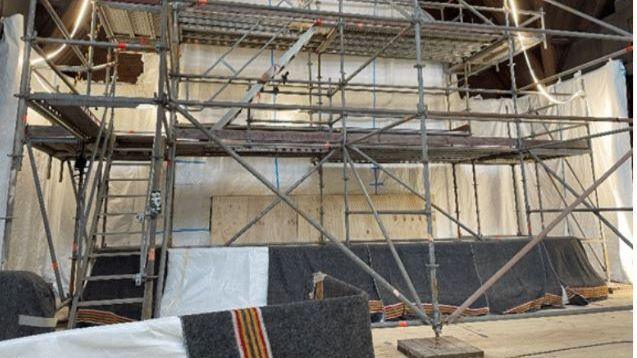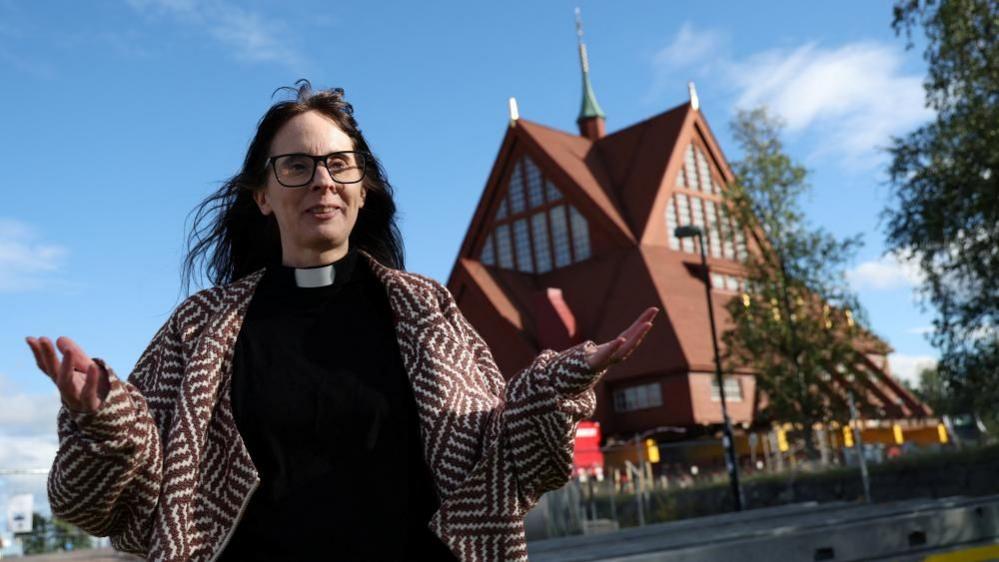Entire church begins two-day journey across Swedish city
Watch: Swedish church on the move to new location
- Published
A landmark 113-year-old church at risk from ground subsidence is being relocated in its entirety - in a 5km (3 miles) move along a road in Sweden's far north.
The vast red timber structure in Kiruna dating back to 1912 has been hoisted on giant trailers and is on its way to the new city centre.
Travelling at a maximum speed of 500m an hour, the journey is expected to take two days.
The old city centre is at risk from ground fissures after more than a century of iron ore mining. The church's move is the most spectacular and symbolic moment of the wider relocation of buildings in Kiruna, which lies 145km north of the Arctic Circle.

The journey began with a blessing from the church's vicar, Lena Tjärnberg, and Bishop Åsa Nyström of the Diocese of Luleå.
As the short ceremony ended, engines rumbled to life and the massive wooden church began inching forward. In the first hour, it managed just 30m, the trailers' wheels slowly turning under its weight.
Large crowds lined the streets under clear blue skies, watching in awe as the timber structure rolled forward. Safety barriers kept people back, but the building passed so close that many said it felt as though they could almost reach out and touch it.
"It's a big crowd. People came not just from Kiruna and other parts of Sweden. I heard many different languages being spoken," said culture strategist Sofia Lagerlöf Mättää. "It's like history taking place in front of our eyes."
The man in charge of the move, project manager Stefan Holmblad Johansson, said: "It's a historic event, a very big and complex operation and we don't have a margin of error. But everything is under control."
By the mid-2010s, other buildings in Kiruna were already being shifted to safer ground. Most were demolished and rebuilt, but some landmarks were moved intact.
These include buildings in Hjalmar Lundbohmsgården such as the so-called yellow row of three old wooden houses and the former home of mining manager Hjalmar Lundbohm, which was split into three parts.
The clock tower on the roof of the old city hall was also moved and can now be found next to the new city hall.

The church has been at its current location since 1912
Under Swedish law, mining activity cannot take place under buildings.
Robert Ylitalo, chief executive officer of Kiruna's development company, explained: "There's no risk of people falling through cracks. But fissures would eventually damage the water, electricity and sewage supply. People have to move before the infrastructure fails."
The iron ore mine's operator, LKAB - also Kiruna's biggest employer - is covering the city's relocation bill, estimated at more than 10bn Swedish krona ($1bn; £737m).
Kiruna Church is 35m (115ft) high, 40m wide and weighs 672 tonnes. It was once voted Sweden's most beautiful pre-1950 building.
Relocating such a large building is an unusual feat. But instead of dismantling it, engineers are moving it in one piece, supported by steel beams and carried on self-propelled modular transporters.
"The biggest challenge was preparing the road for such a wide building," said Mr Johansson.
"We've widened it to 24 metres (79ft) and along the way we removed lamp-posts, traffic lights as well as a bridge that was slated for demolition anyway."
Among the onlookers were Lena Edkvist and her husband, who had driven from Gothenburg.
"I'm not a deeply religious person - I only go to church on special occasions. But this is part of my tradition, history and culture," she said. "It feels like an honour that they're moving it intact instead of dismantling it piece by piece."
For Kjell Olovsson, project manager at Veidekke, the contractor leading the relocation, the moment brought calm satisfaction.
"After years of preparation, we're finally moving. I'm thrilled and just enjoying the moment. The weather is good, and I'm confident everything will run smoothly."
Among the most delicate aspects of the move is the protection of the church's interior treasures, especially its great altar painting made by Prince Eugen, a member of Sweden's royal family.
"It's not something hanging on a hook that you just take off," said project manager Mr Johansson.
"It's glued directly onto a masonry wall so it would have been difficult to remove without damage. So it will remain inside the church during the move, fully covered and stabilised. So will the organ with its 1,000 pipes."

The church has been hoisted on a wheeled transportation unit

Interior parts of the church have been secured by metal scaffolding
The move is much more than an engineering marvel for local residents - it's a deeply emotional moment.
"The church has served as a spiritual centre and a gathering place for the community for generations," said Sofia Lagerlöf Määttä, who remembers walking into the church for the first time as a young child with her grandmother.
"The move has brought back memories of joy and sorrow to us, and we're now moving those memories with us into the future."
That feeling is also shared by project manager Stefan Holmblad Johansson, an engineer who doubles as a member of the church's gospel choir.
"This is a very special task for me," he said. "The church was built over a 100 years ago for the municipality by LKAB. Now we move it to the new city. There simply can't be any other way."

The church is leaving a place where it truly belongs, says Vicar Lena Tjärnberg
For the vicar, Lena Tjärnberg, the moment carries added meaning.
"The church is leaving a place where it truly belongs," she said.
"Everyone knows it has to be relocated: we live in a mining community and depend on the mine. I'm grateful that we're moving the church with us to the new city centre but there is also sorrow in seeing it leave the ground where it became a church."
If all goes to plan, the church will reach its new home in the city centre by Wednesday evening.
Swedish television is also broadcasting, external the entire journey live as "slow TV", marking a rare moment when a piece of history does not just survive change - it moves with it.
Related topics
- Published6 March 2014